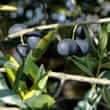Background
- Olive leaves come from the olive tree (Olea europae), a native of the Mediterranean. Although olives and olive oil are used as foods, olive leaf is primarily used medicinally or as a tea.
- Laboratory studies indicate that olive leaf may be beneficial as an antibacterial, antifungal, antiviral, or antioxidant. However, there is insufficient evidence in humans to support the use of olive leaf for any indication.
- In the Middle East, olive leaf tea has been used for centuries to treat sore throat, coughs, fevers, high blood pressure, cystitis (bladder infection), and gout (foot inflammation), and to improve general health. Olive leaf poultices have been applied to the skin to treat dermatological conditions, such as boils, rashes, and warts.
References
- Konlee M. A new triple combination therapy. Posit.Health News 1998;(No 17):12-14.
View Abstract - Lee-Huang S, Zhang L, Huang PL, et al. Anti-HIV activity of olive leaf extract (OLE) and modulation of host cell gene expression by HIV-1 infection and OLE treatment. Biochem Biophys Res Commun. 8-8-2003;307(4):1029-1037.
View Abstract - Markin D, Duek L, Berdicevsky, I. In vitro antimicrobial activity of olive leaves. Mycoses 2003;46(3-4):132-136.
View Abstract - O'Brien NM, Carpenter R, O'Callaghan YC. Et al. Modulatory effects of resveratrol, citroflavan-3-ol, and plant-derived extracts on oxidative stress in U937 cells. J Med Food 2006;9(2):187-195.
View Abstract







